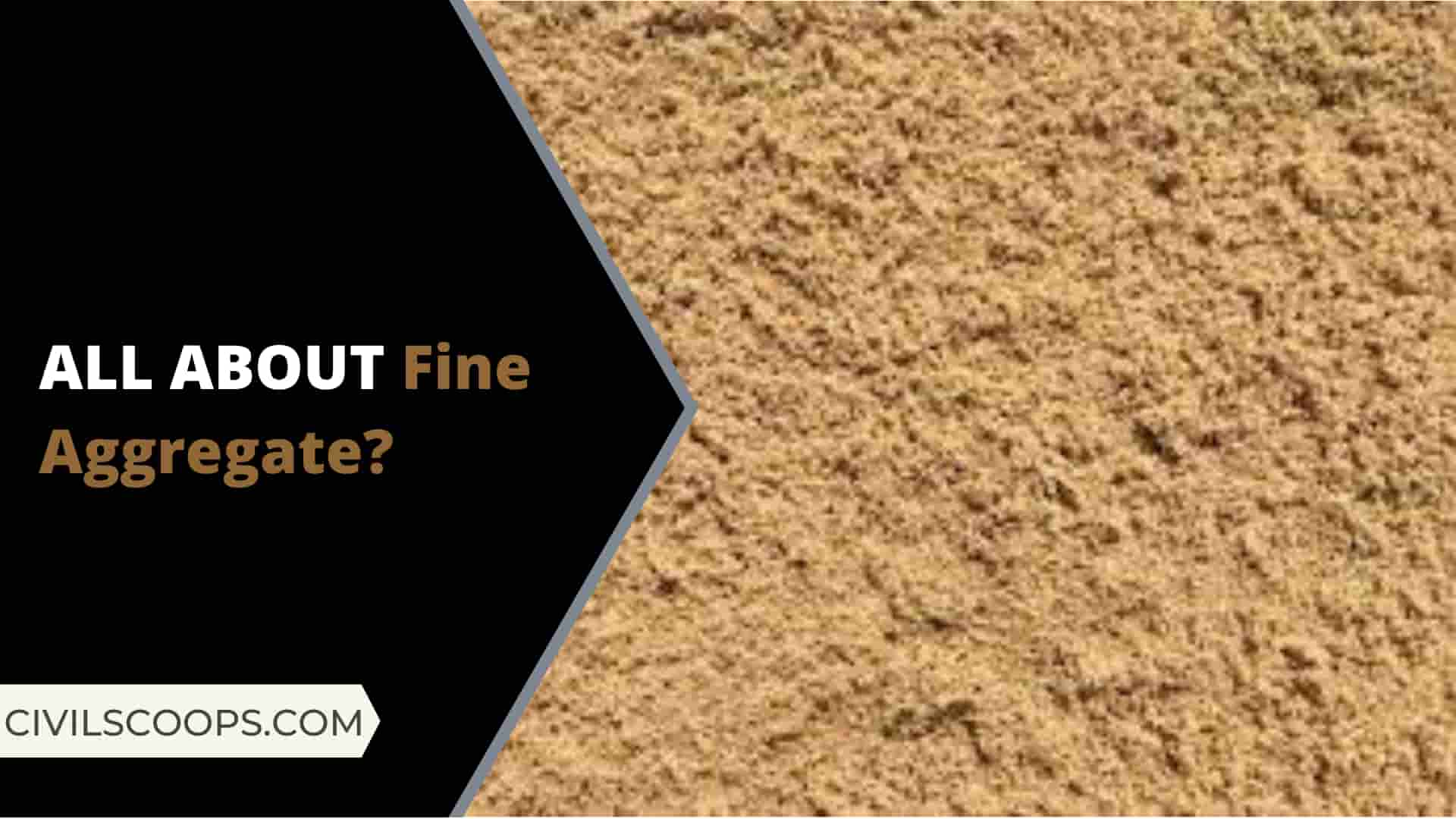
Table of Contents
What Is Fine Aggregate?

Fine aggregates are essentially any natural sand particles won from the land through the mining process. Fine aggregates consist of natural sand or any crushed stone particles that are ¼” or smaller. This product is often referred to as 1/4’” minus as it refers to the size, or grading, of this particular aggregate.
or
Fine aggregate (Sand) Fills voids between aggregates. It forms the bulk and makes mortar or concrete economical. It provides resistance against shrinking and cracking. It is naturally available.
Types of Fine Aggregates (Classification)

Fine aggregates are classified as follows:
- Mode of Origin
- Composition
- Grain Size
1. Classification According to Mode of Origin:
Here, we have divided the sand into three parts as per the origin.
- Pit Sand.
- River Sand.
- Sea Sand.
1.1. Pit Sand-
They are sharp and angular in outline. Translation and deposition are done by the wind. Such sand accumulation is sometimes covered by clay.
It will be desirable to wash and clean this type of sand before use.
1.2. River Sand-
River sand is found in the river bed in-plane area. Grains of river sand is round in shape. This sand is clean and free from salt encrustations.
No organic impurities are noticed. This sand is commonly for construction work.
1.3. Sea Sand-
This type of sand is found on beaches and along sea-shore. These sand particles are round in shape. Grains are often found covered with salts that are not easily separated.
These salts, when coming in contact with binding material of mortar or concrete, create problems. Further, these salts’ encrustations are hygroscopic. They absorb water from the atmosphere and delays setting.
They produce dampness and efflorescence. Hence the type of sand is not preferred. They should be thoroughly washed before use.
2. Classification of Fine Aggregates According to Composition:
Here, we have divided the sand into three parts as per the composition.
- Clean Sand
- Silty Sand
- Clayey Sand
2.1. Clean Sand-
These are well-graded sand containing quartz particles in a wide range of grain sizes.
2.2. Silty Sand-
These are poorly graded, having a considerable proportion of silt and other non-plastic fines.
2.3. Clayey Sand-
There is poorly graded sand that has a prominent clay fraction and also plastic fines.
3. Classification Fine Aggregate According to Grain Size:
According to this classification sands are classified as under,
| Grain Size | Type |
| 2 – 1 mm | Coarse |
| 1 – 0.25 mm | Medium |
| 0.25 – 0.15 mm | Fine |
Fine Aggregate Size Requirement As Per IS 456

If you remember, I have mentioned the size of the fine aggregate as recommended by IS. Let me recall. The aggregates passing through a 4.75 mm sieve and retained in a 0.15 mm sieve are called fine aggregates.
Different size of sand is necessary for different works. For sand times terms like fine sand, medium sand, and coarse sand are used.
It is difficult to distinguish one type of sand from others when such terms are used. It is advisable to express sand in terms of fineness modulus.
According to F.M. sand can be classified as under.
| Type of Sand | Range of Fineness |
| Fine Sand | 2.2 – 2.6 |
| Medium Sand | 2.6 -2.9 |
| Coarse Sand | 2.9 – 3.2 |
Sand having a fineness modulus of more than 3.2 will not be suitable for making satisfactory concrete.
As I have stated earlier considering grain size, types of sand will be as under,
| Type of Sand | Grain Size |
| Coarse Sand | 2-1 mm |
| Medium Sand | 1 – 0.25 mm |
| Fine Sand | 0.25 – 0.15 mm |
Use of Ine Aggregate for General and Specific Purpose.
As per the below type of sand
- Use of sand for general purposes
- Specific Uses of Sand
Use of Sand for General Purposes
- Preparing mortar for masonry work.
- Preparing mortar for different types of plastering and paintings.
- Preparing concrete for a slab, beams, columns, etc.
- Filling in trenches
- Leveling ground
- Foundation Concrete
- Floorings
- Different types of precast units, tiles, concrete pipes, etc.
- Preparing concrete for a slab, beams, columns, etc.
Specific Uses of Sand
Sand can be used for many specific purposes; some important uses are mentioned below.
- To safeguard foundations in back cotton soil.
- Filling in breaches of canal banks.
- Temporary cofferdam
- Blotting excessive bitumen from the surface of the road.
- For playgrounds
- Molding works
- Sand-blasting for cleaning
- Counter-weights (Sand Bages)
Properties of Fine Aggregate
- Size of Fine Aggregates.
- Strength.
- The shape of Fine Aggregates.
- Specific Gravity.
- Surface Texture of Fine Aggregates.
- Water Absorption.
- Surface Index of Fine Aggregates.
- Soundness.
- Surface Moisture.
- Specific Surface of Fine Aggregates.
Fine Aggregate:
Aggregate is the granular material used to produce concrete or mortar and when the particles of the granular material are so fine that they pass through a 4.75mm sieve, it is called fine aggregate.
Like this post? Share it with your friends!
Suggested Read-
- All About Rat Trap Bond | What Is Rat Trap Bond | How to Use | Advantage & Disadvantage of Rat Trap Bond
- All About Fish Ladder | What Is Fish Ladder | Types of Fish Ladder | Fish Ladders in Dams
- All About Pier and Pile | Difference Between Pier and Pile | What Is Pier | What Is Pile
- All About Flooring | What Is Flooring | 11Types of Flooring.
- All About Polymer Concrete | Why Is Polymer Concrete | Types of Polymer Concrete